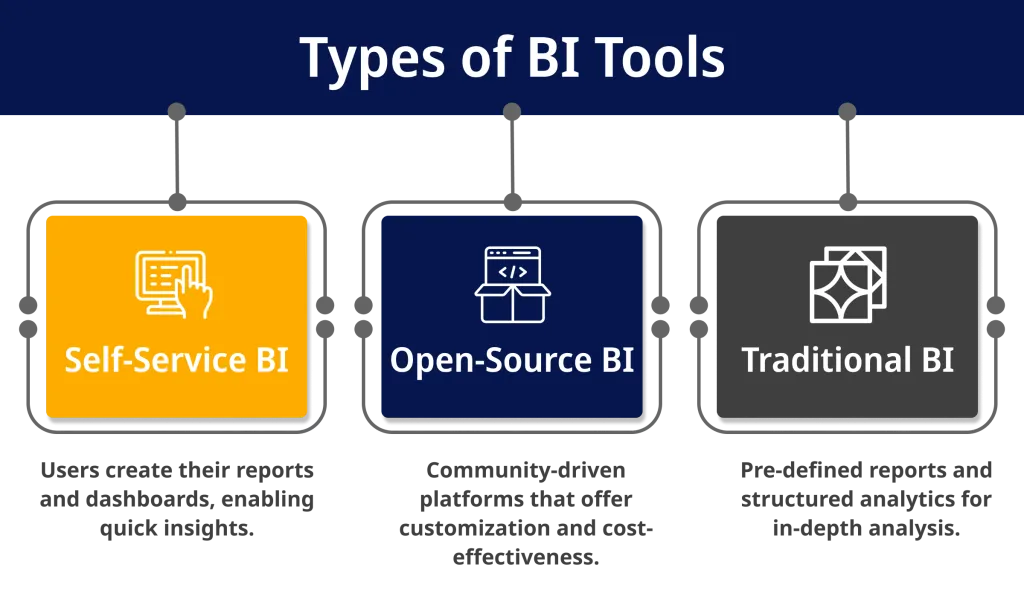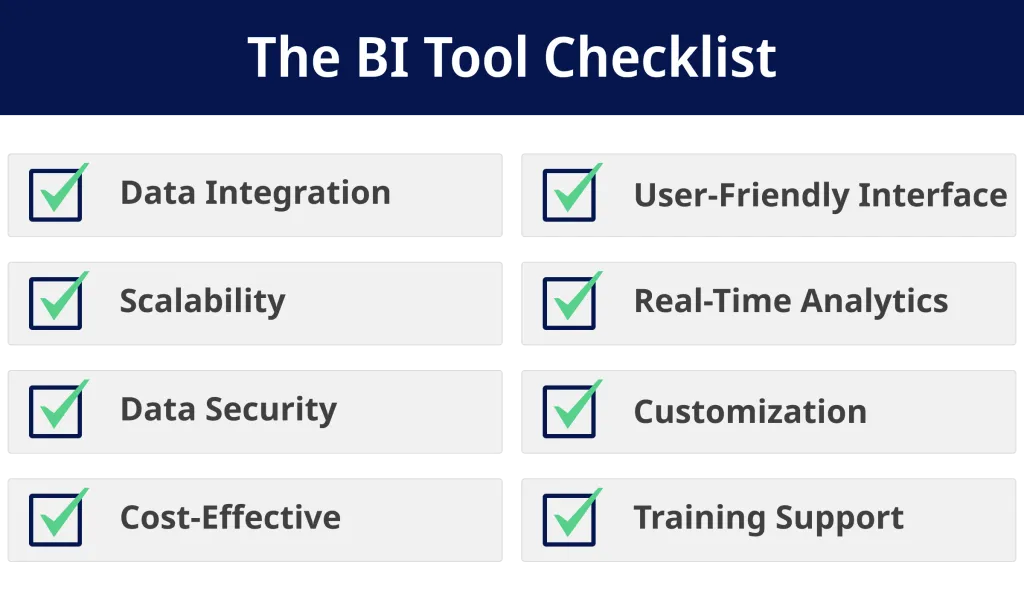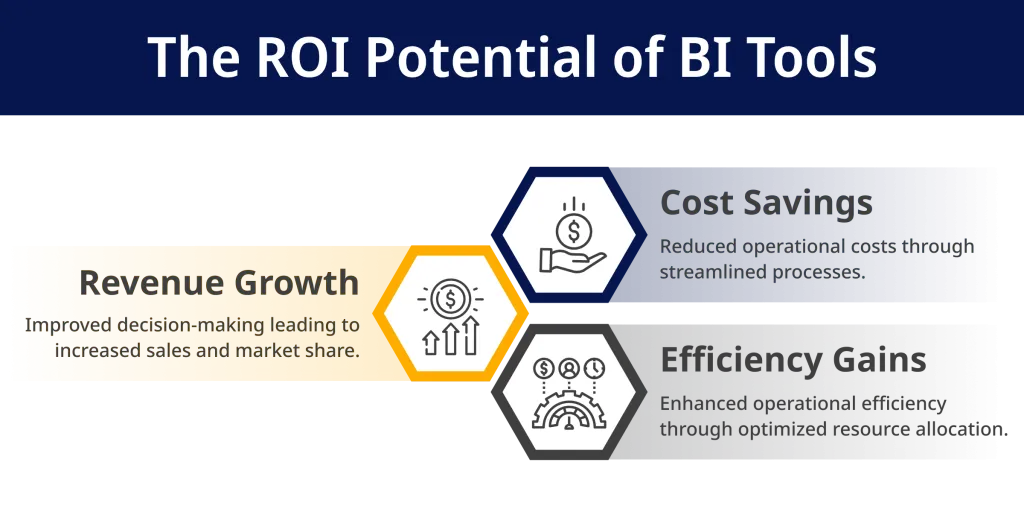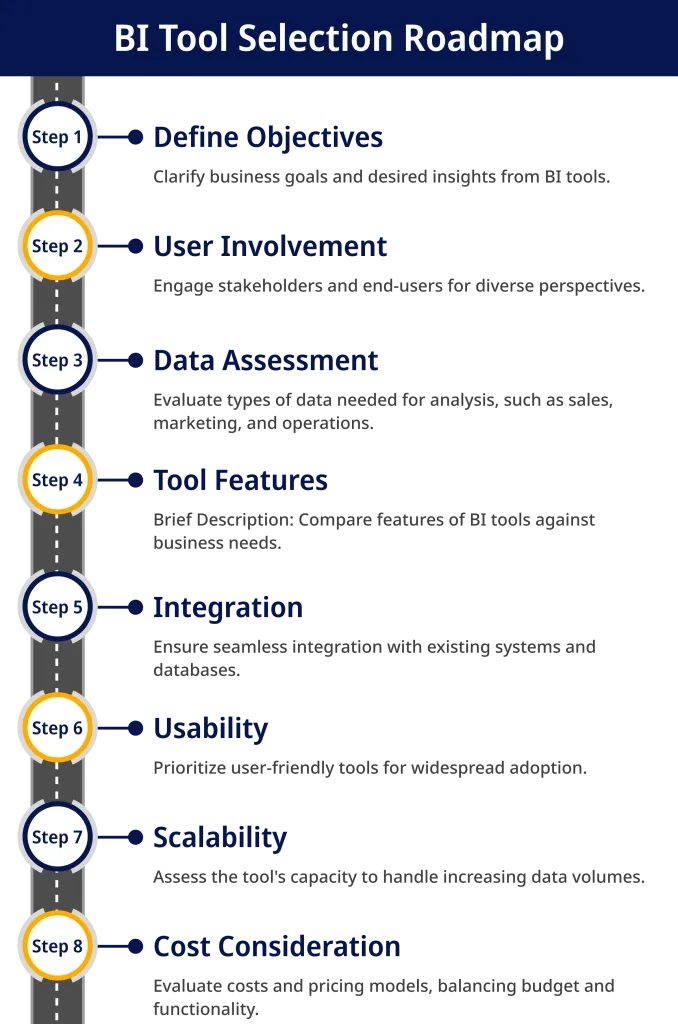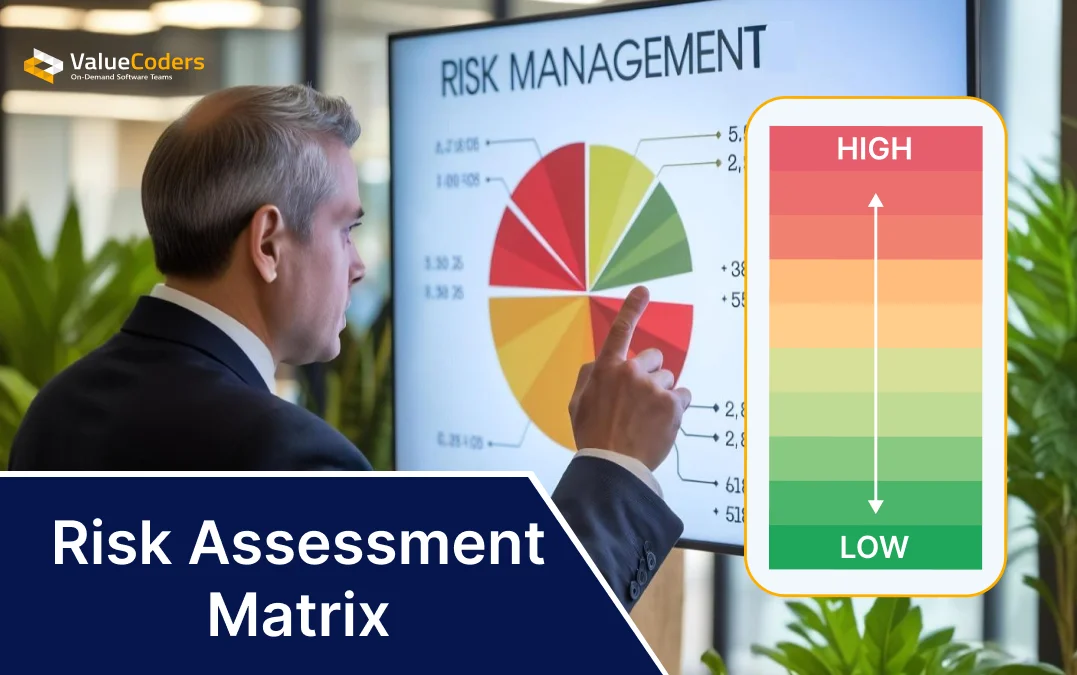In today’s busy business world, using information to make smart decisions is really important. But if companies don’t have the right tools to gather, understand, and show information, it can be hard to learn useful things from all the data they have.
Picking the best tools for this job is a big decision that can greatly help a company if it’s done right. But there are so many choices out there, and they all seem really fancy, making it hard to decide.
This guide will help you understand what to think about when choosing a tool for handling business information. We’ll talk about important things like what the tools can do, how much they cost, how hard they are to start using, and how to pick the right company to get them from. This will make it easier for you to decide which one to get.
Let’s start!
How Business Intelligence Tools Can Help Your Business
BI tools can bridge the gap between raw data and actionable insights, allowing organizations to decipher patterns, uncover trends, and make strategic choices that propel growth.
In industries like manufacturing, where efficiency and resource optimization are critical, tools powered by Manufacturing Data Analytics play a crucial role. By analyzing production data, inventory management, and supply chain operations, businesses can streamline processes and reduce costs, driving overall efficiency.
With the help of Business Intelligence & analytics solutions, you can achieve efficiency and better results in your business. Here is how:
1. Informed Decision-Making: BI tools sift through the vast data landscape, extracting valuable information. These insights aren’t just numbers; they’re the keys that unlock a deeper understanding of market dynamics, customer behavior, and operational efficiency. With this knowledge, businesses can make the right decisions regarding enterprise software development services based on evidence rather than guesswork.
2. Strategic Planning: With BI tools, businesses gain a panoramic view of their operations. They can identify areas of strength, weaknesses that need addressing, and opportunities waiting to be seized. This vantage point enables strategic planning that aligns with organizational goals and market realities. Additionally, with the help of strategic planning, the businesses choose the right BI implementation services.
3. Competitive Edge: Data is the new currency in today’s competitive landscape. BI tools for businesses empower you to gain insights into the competitors’ moves, market trends, and customer preferences. With this intelligence, you can innovate, adapt, and stay ahead in the race.
4. Customer-Centric Approach: Understanding customer preferences and behaviors is no longer optional; it’s essential. BI tools for businesses offer the means to analyze customer interactions, feedback, and buying patterns. This information empowers them to tailor their products, services, and marketing efforts to meet customer demands effectively. With the assistance of data analytics consulting services, businesses can implement customer-centric approaches efficiently.
5. Real-Time Monitoring: BI tools provide real-time or near-real-time data analysis. This dynamic monitoring allows businesses to detect deviations from established norms promptly. Whether identifying a sudden spike in demand or detecting operational bottlenecks, BI tools ensure that businesses remain agile and responsive.
6. Resource Optimization: Wastage of resources is a bane for any organization. BI tools reveal insights into resource utilization, helping businesses optimize their supply chains, manage inventory, and allocate budgets more efficiently.
Adopt our tailored solutions in action
Key Capabilities to Look for in a BI Tool
At its core, the fundamental purpose of a BI platform is to help businesses make data-driven decisions by turning raw data into meaningful insights. This is one of the reasons why they often hire Microsoft Power BI developers for their businesses.
Following are some of the integral features and functionalities your BI tool should offer:
Also Read – How Business Intelligence is Driving Success in Today’s Market
1. Powerful Reporting and Visualizations
The number one capability any BI platform must provide is easily generating reports and visualizations that transform complex data sets into intuitive, graphical representations like charts, graphs, and dashboards.
The BI tool for businesses should let users create, customize, and distribute interactive reports and dashboards with drag-and-drop simplicity.
Look for strong visual design features, drill-down capabilities, and flexibility to present data at multiple levels, from high-level overviews to granular views.
The ability to schedule and automate report generation is also highly desirable.
Leading solutions like Tableau, Sisense, and Domo are popular for their robust visualization capabilities.
2. Seamless Data Connectivity
The BI platform pulls data from disparate sources like CRM tools, ERP systems, databases, cloud applications, etc. So, the solution must offer pre-built connectors and integration to seamlessly aggregate all this data using cloud ETL tools for extract, transform, and load (ETL) processes.
This enables combining data from across the organization into a unified, cleansed, and consistent data model to run queries and analytics.
Platforms like Microsoft Power BI simplify data preparation with intuitive ETL interfaces, whereas Informatica specializes in enterprise-grade ETL capabilities.
3. Sophisticated Analytics and Predictions
Harnessing the predictive power of data is the defining capability of modern BI tools.
The solution should provide built-in support for advanced analytics like forecasting, regression analysis, predictive modeling, machine learning algorithms, and sentiment analysis to uncover what happened and predict what could happen.
Look for statistical libraries, pre-built analytic functions, and machine learning capabilities to empower users across levels to extract sophisticated insights from data patterns easily. Qlik, SAP Analytics Cloud, and IBM Cognos all offer strong analytics capabilities.
Also Read: The Ultimate Guide To Using Automation Tools In Software Development
4. Flexible Mobile Support
In today’s mobile-centric world, a key prerequisite for any enterprise software is the availability of fully functional mobile apps for on-the-go access on smartphones and tablets.
For BI tools, intuitive native apps that allow users to securely view, analyze, and share dashboards and insights from anywhere can accelerate adoption across the organization.
Supporting offline data access is also beneficial for remote or field users. MicroStrategy, Yellowfin, and Looker are among the top mobile BI apps with features like push notifications, alerts, and messaging.
5. Robust Governance and Security
When dealing with sensitive organizational data, security is paramount. Your BI tool should provide comprehensive user access controls, multi-layered authentication mechanisms, data encryption, role-based permissions, and auditing to govern data while blocking unauthorized access.
Validate security certifications and protocols for infrastructure and data centers for cloud-based BI platforms.
On-premise solutions will require configuring security protocols internally. Leading options like ThoughtSpot offer enterprise-grade security tailored for the BI environment.
6. Flexible Pricing Models
BI platforms can vary significantly in their pricing models and associated costs.
Some of the most common pricing models for BI implementation services are:
- Per-user licensing is based on named or concurrent users
- Volume-based pricing according to the ingested data volume
- Tiered plans based on features and capabilities
- Consumption-based pricing for cloud solutions
- Additional charges for support, maintenance, and training
Evaluate costs against your current and projected usage and team size. Per-session licensing may be suitable for occasional users, whereas unlimited or enterprise licenses work for large organizations.
Solutions like Tableau balances powerful analytics with flexible pricing. You can also consider open-source BI software to minimize licensing costs.
Subscribe for expert guidance on the perfect BI tools for your business needs.
Key Factors to Consider When Choosing a BI Tool
Here are some of the pivotal factors to consider when evaluating BI tools for businesses:
-
Align With Business Requirements
Firstly, take a step back to comprehensively evaluate your organization’s BI needs and priorities before getting carried away by vendor features.
Analyze the capabilities that maximize ROI for your use cases, like advanced analytics, customizable dashboards, broad data access, or ad hoc reporting.
Define must-have, nice-to-have, and optional criteria based on your infrastructure, team skills, and long-term objectives.
Setting requirements upfront will help you zero in on the BI product that best fits your needs and prevent overspending on unnecessary capabilities.
-
Prioritize Ease of Use
The success of your BI implementation hinges greatly on end-user adoption. Complex tools with steep learning curves often lead to low utilization rates and failure to achieve data democratization.
Prioritize solutions with highly intuitive interfaces, interactive visualizations, and natural language queries to minimize training needs.
Evaluate capabilities like AI-powered augmentation, smart data discovery, and automated insights to empower users of diverse skill sets to engage meaningfully with data and foster a data-driven culture in your organization.
Also Read : How Power BI And OLAP Cubes Improve Your Business
-
Ensure Adequate Vendor Support
Lack of ongoing customer support can diminish your BI platform’s value. Evaluate each shortlisted vendor’s support offerings, like online resources, community forums, email assistance, live chat, phone support, and premium packages.
Give importance to accelerated response times, availability in your time zone, and expertise in managing deployments end-to-end.
Vendor support is packaged with licensing for cloud BI platforms, like Microsoft Power BI.
-
Account for Implementation Timelines
On-premise BI tools often require lengthy setup and infrastructure development, which can take months before going live.
Prioritize cloud-based solutions if you need accelerated time-to-value. Leading SaaS platforms like Sisense Cloud offer pre-built integrations to help users import, prepare, analyze, and share data within days.
Consider solutions like Qlik Sense that offer flexible on-premise and SaaS options. You can start with SaaS and then migrate workloads on-premise later as usage scales.
-
Evaluate Interoperability
Your chosen BI platform should integrate tightly across your enterprise technology stack, including databases like SQL, applications like Salesforce, and analytics tools like Python and R.
Scrutinize API availability, pre-built connectors, development resources, and compatibility with programming languages to enable embedding analytics seamlessly. Solutions like Sisense, Domo, and Looker score high on interoperability.
-
Assess Vendor Viability
Shortlisting vendors with stability and longevity pertinent to the BI market can minimize business risk.
Analyze factors like years in business, financial standing, market share, leadership team, customer base growth, partnerships, and future roadmap.
Trusted vendors like Microsoft, SAP, Oracle, and IBM have decades of BI and data analytics expertise.
Companies like ValueCoders and PixelCrayons offer market-disrupting capabilities. Blend incumbents and innovators on your evaluation list.
Make data-driven decisions effortlessly with BI tool
Potential Challenges and Pitfalls to Avoid
While BI tools for businesses hold tremendous potential, realizing the full benefits involves navigating a minefield of potential implementation challenges.
Being aware of these pitfalls upfront can help you proactively avoid them.
Here are some key challenges to consider:
- Integrating Disparate Data Sources: As mentioned earlier, a key technical challenge is seamlessly integrating and preparing heterogeneous enterprise data from numerous sources for analysis. Without robust ETL capabilities, data accessibility and consistency can severely limit BI value.
- Overcoming Organizational Resistance: Rolling out a new enterprise software often faces inertia and lack of enthusiasm from employees wedded to old systems and processes. Convincing users of the new BI platform’s potential through training and communication is vital for adoption.
- Managing Data Governance: Lack of data security protocols and access controls can lead to the utilization of inaccurate or unauthorized data and incorrect insights. Defining data governance policies on the front end is critical.
- Avoiding Shelfware Syndrome: The “build it, and they will come” mindset often leads to low user adoption and wasted investments. Focus on user-centric design and change management to drive engagement.
Remember these challenges, emphasize user adoption and data governance, and ensure executive sponsorship to maximize your BI platform’s success.
Also Read – The Future of Business Intelligence: What to Expect in the Coming Years
Conclusion
With today’s wide range of BI software options, settling on the right platform for your needs may seem daunting. However, you can zero in on the ideal solution by carefully evaluating your key requirements, budget constraints, and long-term analytics strategy.
The most critical step is aligning your business objectives and identifying where gaps exist that BI can fill. This clarity lets you match specific use cases to vendor capabilities during vetting.
While technical features are important, don’t overlook ease of use and adoption. The most powerful analytics platform is useless if the staff doesn’t leverage it.
Prioritize solutions that make insights accessible across roles with flexible dashboards and reporting.
And remember – your BI needs will evolve. Seek a platform to grow with your analytics ambitions and scale from basic reporting to advanced capabilities like predictive modeling and machine learning. The right foundation puts you in a position to expand.
With clear criteria and an impartial side-by-side comparison, the ideal BI match for your organization will reveal itself.
Invest the time upfront to make a data-driven decision when selecting tools. Like your business decisions, choose the platform that optimizes what matters most and prepares your company to become insight-driven.

